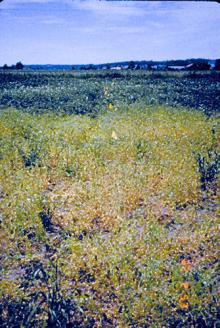Cause The cyst nematode, Heterodera goettingiana, is an aggressive parasite that can be quite damaging to a pea crop. Cysts are the dead bodies of females and may contain up to 300 eggs. Cysts are very persistent in the soil, surviving more than 12 years, and can be spread by moving contaminated soil. Pea and fava bean are the main economic hosts. Certain vetches also can be hosts. Root invasion is promoted by cool soil temperatures (about 55°F). Thus peas planted early can be affected more severely than late plantings. Pea varieties show little difference in their susceptibility to the cyst nematode.
Symptoms Infected peas are stunted with yellowing leaves, and leaves tend to point up. Foliage symptoms often are not evident until bloom, when yellowing spreads rapidly from the bottom of the plant to the top. Sometimes the color is a very bright yellow. Invaded plants lack fibrous roots and nitrogen-fixing nodules. Tiny (less than 0.5 mm) cream-color, lemon-shaped cysts can be found embedded in root tissue, but once cysts mature and turn dark brown, they detach easily from root systems and are difficult to detect. Initial damage to the field is restricted to small distinct areas, but with further cropping to pea, the areas expand.
Sampling Collect soil samples in late winter or early spring before planting. The threshold of economic damage is five or more eggs per gram of soil. Yield loss may be 20% at five eggs per gram; complete crop failure can occur at 20 or more eggs per gram. Send samples to any of several private or public laboratories, or test at home using sugar water and a magnifying lens. Contact WSU-Mt. Vernon for details.
Cultural control
- Crop rotation effectively reduces soil populations because the nematode has a limited host range. Rotate 4 years out of host crops unless the field is infested at an economically damaging level; then, an even longer break is needed.
- Avoid planting fava bean in fields with this nematode.
- Plant later when soil temperature has warmed.
Biological control
- MeloCon WG at 2 to 4 lb/A for nematode suppression. See label for specific application types and timings. 4-hr reentry. O
Reference Inglis, D.A. 1998. Pea cyst nematode: biology and prevention. WSU Cooperative Extension Bulletin 1872.



